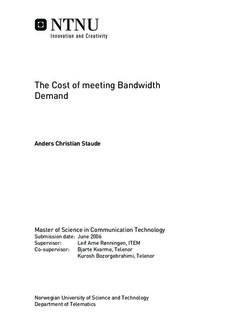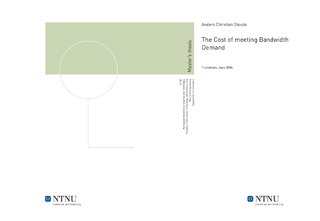| dc.description.abstract | Telenor is faced with complex decisions regarding their access network strategies. Competitors are given the right to use Telenor s copper access network through LLUB (Local Loop Un-Bundling) regulations. Competition is also seen from alternative access networks. Both implying lost customers and lost revenues. At the same time, the accumulated demand for bandwidth is increasing to a level beyond what can be accommodated by Telenor s current access network. Failing to meet this demand will result in further lost revenues.This thesis uses the expected growth in bandwidth demand to motivate an upgrade of Telenor s access network. Several schemes and technologies are considered. Finally three different solutions are chosen for an in-depth business case analysis. As part of this analysis, a set of models are created. These models can be used to calculate investment costs of an arbitrary area. The models are used on six different areas in and around Trondheim.New applications and services such as Peer-to-Peer, Streaming and Video-on-Demand are increasing the demand for bandwidth among home users. There is also a trend towards an access network convergence. Traditionally, basic services would have dedicated access networks. This is changing. The product called Triple Play (3P) is perhaps the best example. This is telephony, TV and Internet access all offered on one access network with one bill. Various fiber based solutions or an improvement of current xDSL technology are those options relevant to Telenor Nordic. A point-to-point (P2P) fiber solution, a passive optical network (PON) and a VDSL2 solution are chosen for a business case analysis. The two former solutions are considered capable of meeting long term demand. The latter solution is considered capable of meeting medium to long term demand. By applying the models created and using a Telenor GIS (Geographic Information System) tool for measurements, results are obtained. They indicate that a VDSL2 solution is the cheapest way of providing bit rates above 70 Mbit/s to all customers. In urban and sub-urban areas VDSL2 is approximately 50 % cheaper than fiber-based solutions. In rural areas, the difference between a PON solution and VDSL2 is reduced. A P2P solution remains the most expensive, but now by far. The net present value analysis show positive values for all solutions in urban and sub-urban areas. The rural areas seem unprofitable according to any standard.The presence of available fiber becomes a crucial factor in determining deployment costs for PONs. In the case of a P2P solution, existing available ducts are highly desirable. The fear of high deployment costs related to expensive civil work in urban areas, seem needless. The high population density and availability of existing infrastructure in these areas easily compensates expensive civil work. | nb_NO |

